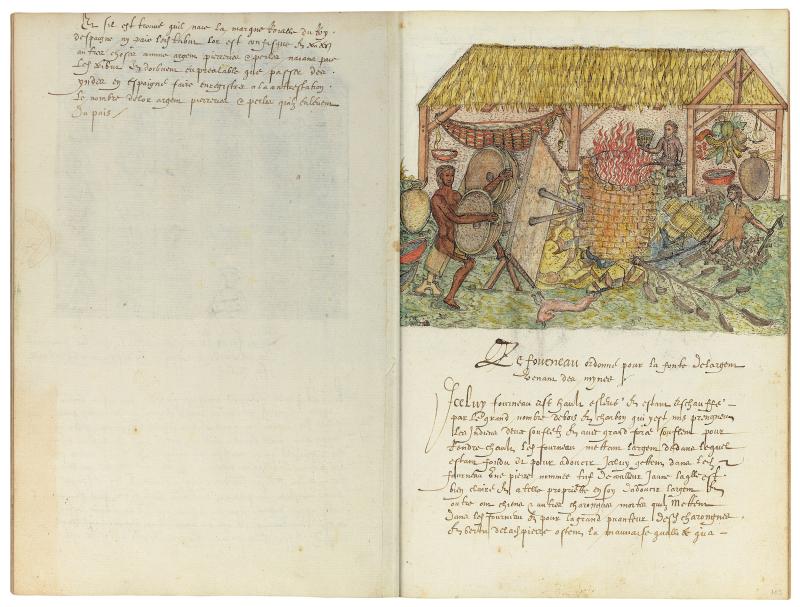
Histoire Naturelle des Indes
Illustrated manuscript
Bequest of Clara S. Peck, 1983
Continued from fol. 102
When it is found that there is no royal stamp by the King of Spain and the tribute has not been paid, the gold is confiscated and everything else, such as silver, precious stones and pearls; before passing from the Indies to Spain, they must register at the contrestation the amount of gold, silver, gems and pearls they take out of the country.
Le Fourneau Ordonne Pour La Fonte Delargent Venant Des Mynes (The Furnace Prescribed for the Smelting of the Silver Coming from the Mines)
This furnace is placed high and is being heated with a great deal of wood and charcoal which is put inside. The Indians take two bellows and blow into them with great force to make the furnace hot. They put the silver inside which is being melted and, in order to soften it, they throw a stone called tuf (or tufa), yellow in color, into the furnace which is a very bright and has the capacity of softening the silver. They also put dead dogs and other carrion into the furnace and with the strong stench of the carrion and the help of the stone, they remove the bad quality
In 1983, The Morgan Library & Museum received, as the bequest of Clara S. Peck, an extraordinary volume whose beautiful paintings and descriptions document the plant, animal, and human life of the Caribbean late in the sixteenth century. Spaniards had already begun to exert influence over the indigenous people of the area when explorers from England and France arrived, among them Sir Francis Drake. The volume, known as the Drake Manuscript and titled Histoire Naturelle des Indes when it was bound in the eighteenth century, gives us a wonderful picture of daily life at the time of Drake's many visits to the region. Although Drake's connection to the manuscript is uncertain, he is mentioned on more than one occasion by the authors. Drake himself is known to have painted, but none of his work survives.
Contents: 199 images of West Indian plants, animals and human life, with accompanying manuscript captions written in late sixteenth-century French.
Medium: Most of the illustrations consist of a black chalk underdrawing and a combination of pen and brown ink with watercolor; on some images selected areas have also been glazed with a gum.
Binding: Bound or rebound in brown leather in the late 18th century.
Pagination: Penciled folio numbers (1–125) in lower right corner of each page were added by The Morgan Library & Museum. Folios 92v–93, 93v–94, and 95v–96 are fold-out leaves.
